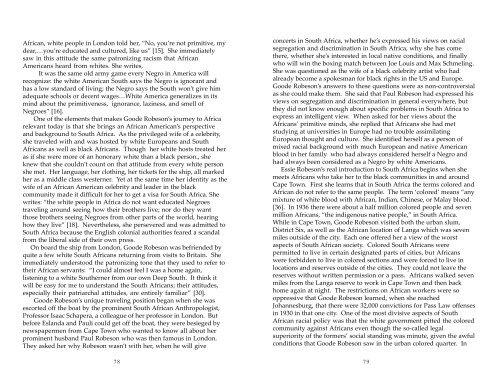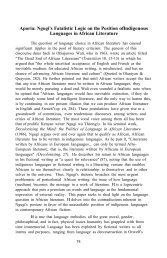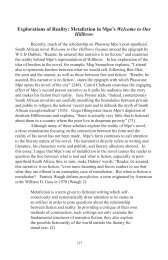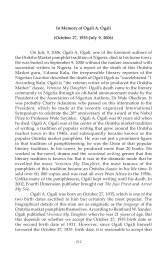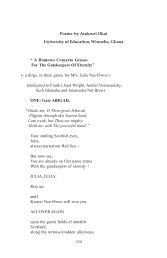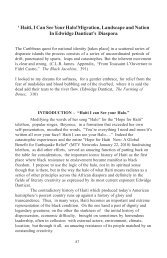Eslanda Goode Robeson's African Journey
Eslanda Goode Robeson's African Journey
Eslanda Goode Robeson's African Journey
You also want an ePaper? Increase the reach of your titles
YUMPU automatically turns print PDFs into web optimized ePapers that Google loves.
<strong>African</strong>, white people in London told her, “No, you’re not primitive, my<br />
dear,…you’re educated and cultured, like us” [15]. She immediately<br />
saw in this attitude the same patronizing racism that <strong>African</strong><br />
Americans heard from whites. She writes,<br />
It was the same old army game every Negro in America will<br />
recognize: the white American South says the Negro is ignorant and<br />
has a low standard of living; the Negro says the South won’t give him<br />
adequate schools or decent wages…White America generalizes in its<br />
mind about the primitiveness, ignorance, laziness, and smell of<br />
Negroes” [16].<br />
One of the elements that makes <strong>Goode</strong> Robeson’s journey to Africa<br />
relevant today is that she brings an <strong>African</strong> American’s perspective<br />
and background to South Africa. As the privileged wife of a celebrity,<br />
she traveled with and was hosted by white Europeans and South<br />
<strong>African</strong>s as well as black <strong>African</strong>s. Though her white hosts treated her<br />
as if she were more of an honorary white than a black person., she<br />
knew that she couldn’t count on that attitude from every white person<br />
she met. Her language, her clothing, her tickets for the ship, all marked<br />
her as a middle class westerner. Yet at the same time her identity as the<br />
wife of an <strong>African</strong> American celebrity and leader in the black<br />
community made it difficult for her to get a visa for South Africa. She<br />
writes: “the white people in Africa do not want educated Negroes<br />
traveling around seeing how their brothers live; nor do they want<br />
those brothers seeing Negroes from other parts of the world, hearing<br />
how they live” [18]. Nevertheless, she persevered and was admitted to<br />
South Africa because the English colonial authorities feared a scandal<br />
from the liberal side of their own press.<br />
On board the ship from London, <strong>Goode</strong> Robeson was befriended by<br />
quite a few white South <strong>African</strong>s returning from visits to Britain. She<br />
immediately understood the patronizing tone that they used to refer to<br />
their <strong>African</strong> servants: “I could almost feel I was a home again,<br />
listening to a white Southerner from our own Deep South. It think it<br />
will be easy for me to understand the South <strong>African</strong>s; their attitudes,<br />
especially their patriarchal attitudes, are entirely familiar” [30].<br />
<strong>Goode</strong> Robeson’s unique traveling position began when she was<br />
escorted off the boat by the prominent South <strong>African</strong> Anthropologist,<br />
Professor Isaac Schapera, a colleague of her professor in London. But<br />
before <strong>Eslanda</strong> and Pauli could get off the boat, they were besieged by<br />
newspapermen from Cape Town who wanted to know all about her<br />
prominent husband Paul Robeson who was then famous in London.<br />
They asked her why Robeson wasn’t with her, when he will give<br />
78<br />
concerts in South Africa, whether he’s expressed his views on racial<br />
segregation and discrimination in South Africa, why she has come<br />
there, whether she’s interested in local native conditions, and finally<br />
who will win the boxing match between Joe Louis and Max Schmeling.<br />
She was questioned as the wife of a black celebrity artist who had<br />
already become a spokesman for black rights in the US and Europe.<br />
<strong>Goode</strong> Robeson’s answers to these questions were as non-controversial<br />
as she could make them. She said that Paul Robeson had expressed his<br />
views on segregation and discrimination in general everywhere, but<br />
they did not know enough about specific problems in South Africa to<br />
express an intelligent view. When asked for her views about the<br />
<strong>African</strong>s’ primitive minds, she replied that <strong>African</strong>s she had met<br />
studying at universities in Europe had no trouble assimilating<br />
European thought and culture. She identified herself as a person of<br />
mixed racial background with much European and native American<br />
blood in her family who had always considered herself a Negro and<br />
had always been considered as a Negro by white Americans.<br />
Essie Robeson’s real introduction to South Africa begins when she<br />
meets <strong>African</strong>s who take her to the black communities in and around<br />
Cape Town. First she learns that in South Africa the terms colored and<br />
<strong>African</strong> do not refer to the same people. The term ‘colored’ means “any<br />
mixture of white blood with <strong>African</strong>, Indian, Chinese, or Malay blood.<br />
[36]. In 1936 there were about a half million colored people and seven<br />
million <strong>African</strong>s, “the indigenous native people,” in South Africa.<br />
While in Cape Town, <strong>Goode</strong> Robeson visited both the urban slum,<br />
District Six, as well as the <strong>African</strong> location of Langa which was seven<br />
miles outside of the city. Each one offered her a view of the worst<br />
aspects of South <strong>African</strong> society. Colored South <strong>African</strong>s were<br />
permitted to live in certain designated parts of cities, but <strong>African</strong>s<br />
were forbidden to live in colored sections and were forced to live in<br />
locations and reserves outside of the cities. They could not leave the<br />
reserves without written permission or a pass. <strong>African</strong>s walked seven<br />
miles from the Langa reserve to work in Cape Town and then back<br />
home again at night. The restrictions on <strong>African</strong> workers were so<br />
oppressive that <strong>Goode</strong> Robeson learned, when she reached<br />
Johannesburg, that there were 32,000 convictions for Pass Law offenses<br />
in 1930 in that one city. One of the most divisive aspects of South<br />
<strong>African</strong> racial policy was that the white government pitted the colored<br />
community against <strong>African</strong>s even though the so-called legal<br />
superiority of the formers’ social standing was minute, given the awful<br />
conditions that <strong>Goode</strong> Robeson saw in the urban colored quarter. In<br />
79


